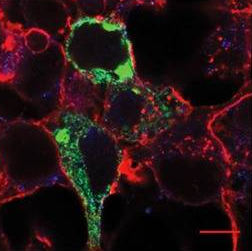Noninvasive Tool Controls Neurons

Optogenetics — a tool that enables researchers to control neurons with light — has transformed neuroscience. But the technique is invasive. Light is typically delivered via a fiber optic cable implanted in an animal’s brain. Researchers have developed a noninvasive alternative: a genetic system for controlling neurons that uses radio waves or magnetic fields instead of light. These signals can freely penetrate tissue, meaning the technique can be used on awake, behaving animals without invasive delivery systems.
The system was created by Sarah Stanley, a physician and scientist at the Icahn School of Medicine at Mount Sinai in New York. It employs two cleverly engineered genes: ferritin fused to green fluorescent protein (GFP) and an ion channel fused to a GFP antibody. (Stanley developed the system as a postdoctoral researcher at Rockefeller University.) When expressed in the cell, the ferritin protein self-assembles into an iron oxide nanoparticle and becomes tethered to the channel via the antibody. Researchers then use radio waves or a magnetic field to energize the nanoparticle and open the channel. By swapping out the ion channels, researchers can use the system to activate or silence neurons.

Stanley and her collaborators have confirmed that the construct can control neurons by directly recording electrical activity (via patch-clamp recording) from neurons expressing the ferritin system. The technique also works in awake, behaving mice. In a paper published in Nature last year, researchers used a virus to deliver the genetic system to glucose-sensing neurons in live animals. When exposed to a magnetic field via magnetic resonance imaging, the animals’ blood sugar rose and they ate more. Turning the neurons off had the opposite effect.
Stanley, who presented the work at the American Association for the Advancement of Science conference in Boston in February, hopes to develop versions with a range of different ion channels. Scientists interested in testing out her system can get the DNA constructs from Addgene.org, a nonprofit plasmid repository. The research is supported by the Brain Research through Advancing Innovative Neurotechnologies (BRAIN) Initiative, launched by President Obama in 2013.


